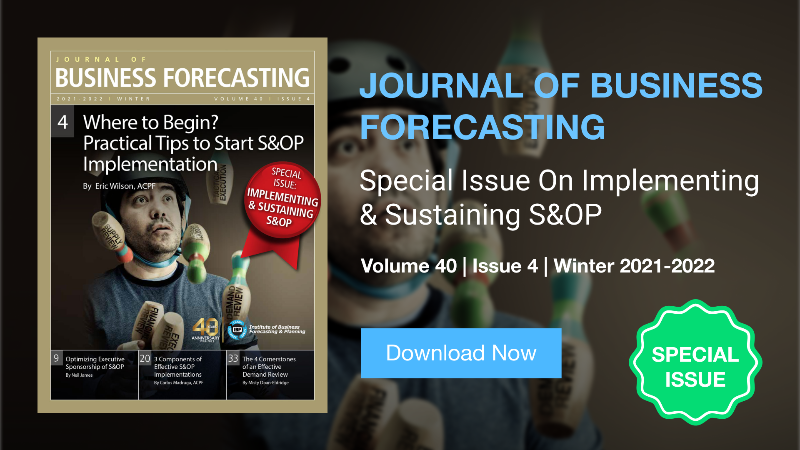S&OP, the topic of this special issue, is a great process for managing demand, which also goes by the name of SIOP (Sales, Inventory and Operations Planning), IBP (Integrated Business Planning) and MIOE (Merchandizing, Inventory and Operations Execution. It doesn’t matter what we call it; the priority is to have a framework that facilitates cross-functional collaboration that serves to balance demand and supply while meeting the strategic goals of the business.
I needn’t mention the impact of COVID on our planning which has forced us to shorten the S&OP cycle from monthly to weekly. Make no mistake, S&OP saved many companies from the brink of disaster since the pandemic struck, as supply shortages and shifting demand wreaked havoc on our businesses. I was pleased to see that planning professionals made adjustments to their usual process to react to pandemic-related disruptions because there are longer term factors that are testing S&OP’s ability to manage demand, which also require new ways of thinking.
S&OP is tried and tested but it is more than 30-years old. Since it was first developed, market dynamics have changed, requiring changes in how we plan. Markets are now demand, not supply driven. Competition is intense. New products are exploding, and so are the channels of distribution. All these have added uncertainty that must be addressed. COVID or no COVID, we must ask ourselves how we can evolve S&OP to response to these shifts.
The increasing importance of new products requires a change to the traditional S&OP process. Although new products are reviewed within the product portfolio, they don’t get the attention they need. A significant amount of revenue comes from them and is growing. McCormick USIG, for example, gets 35% to 45% of its revenue from new products; LEGO, 60%; and Hasbro, 80%. To manage their demand, they require not only more attention, but also special skill sets. The success of new products depends on a robust projection of future sales, but they are difficult to forecast because of lack of history. One way to do it is to prepare three sets of forecasts: frozen (where no change can be made), slushy (where a limited amount of change can be made), and liquid (where any amount of change can be made). The other way is to prepare high and low forecasts — low forecasts for fixed contracts and high for flexible contracts. An S&OP step dedicated solely to new products is required.
Another component that needs to be added to S&OP is eCommerce, which is rapidly growing. If S&OP was conceived around brick-and-mortar sales, eCommerce requires a different skill set and strategy. For example, in eCommerce, customers buy less but more frequently. How they respond to a 24-hour online-flash sale is very different from brick-and-mortar. Since Demand Planners have access to customer data (e.g., how much they bought and when), they can develop a better marketing plan based on recency, frequency, and monetary value. Further, it is much easier to do demand shaping in eCommerce. eCommerce requires more agility in the supply chain because orders must be shipped on time, otherwise, it will lose the sale.
Further, in the omnichannel environment, there are a number of ways a product can be bought and shipped: (1) buy from a store; (2) buy online, ship from a distribution center; (3) buy online, pick up at a store; and (4) buy online, ship from a store. Each option has a different effect on the bottom line because of differences in their operating cost — picking, packing, inventorying, and shipping. These are factors that must be clearly identified and planned for in a dedicated eCommerce step in S&OP.
To keep S&OP robust, we must recognize these issues and have a mechanism to deal with them. Then, perhaps, we can bring S&OP up to date and fit to deal with the advancements we have seen in recent years. You’ll find in this special issue a range of excellent articles designed to help you implement S&OP or to improve an existing process, written by some of the leading figures in the field. I trust you will find them valuable.
I suggest using IBF’s S&OP maturity model in conjunction with reading these articles. Available at www.ibf.org/sop-maturity-model, it’s a free self-assessment that identifies your current S&OP maturity level and provides recommendations to progress to the next level, as well as other helpful resources.
Happy forecasting!
Chaman L. Jain, Editor
Institute of Business Forecasting
This is an extract from the 2021/2022 Special Issue of The Journal of Business Forecasting on implementing and sustaining S&OP. Download an extended preview here or become an IBF member and get both full digital access and the print version delivered to your door every quarter, plus a a host of other member benefits including discounted conferences and training, exclusive workshops, and access to the entire IBF knowledge library.


